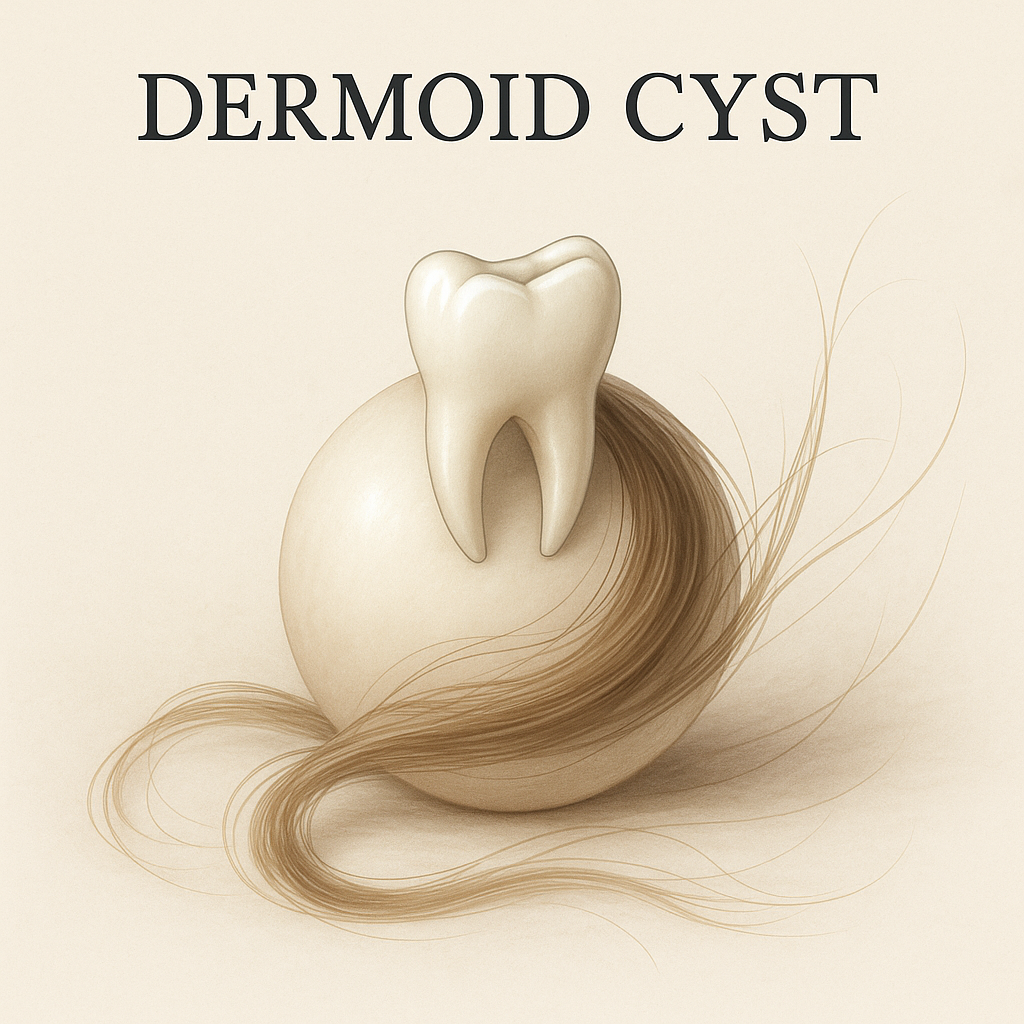Yes, you read that right—a tooth that grew hair. It sounds like a Halloween headline, but it’s a real medical condition caused by a dermoid cyst. These strange growths can contain hair, teeth, skin, oil glands, or even bits of bone. Weird? Absolutely. Dangerous? Not usually.
A dermoid cyst—sometimes called a mature cystic teratoma—forms when early embryonic cells take a wrong turn during development. These “totipotent” cells can form any tissue type, which is why they sometimes assemble a grab-bag of mature tissues in an odd place. Think of it as biology’s misplaced craft project.
How a Dermoid Cyst Forms
During early fetal development, germ cells—primitive cells meant to form eggs or sperm—sometimes become trapped in the wrong location. If those cells remain dormant for years, they may later begin dividing and differentiating into mature tissues such as hair follicles, sebaceous glands, teeth, or even cartilage. The result is a benign tumor that looks more like a patchwork of normal tissues than anything sinister.
The majority of dermoid cysts occur in the ovaries, making up around 90 % of all cases. But they can appear elsewhere too—at the base of the spine (sacrococcygeal area), in the mediastinum (chest), or even in the brain. In rare cases, they can develop in the testicles or under the skin along embryonic fusion lines, such as the neck or face.
Who Gets Them—and Why?
They’re most often discovered in women between 20 and 40 years old, often by accident during imaging for unrelated reasons. About 10–15 % are found in both ovaries. While anyone can technically develop a dermoid cyst, hormonal influences may help trigger their growth. Fortunately, malignant transformation is rare—occurring in less than 2 % of ovarian cases.
Signs and Symptoms
Most dermoid cysts are silent passengers. But when they make their presence known, it’s usually because they’ve grown large enough to cause pressure or twist the ovary.
- Abdominal or pelvic pain—dull or intermittent
- Bloating or fullness from mass effect
- Ovarian torsion—a sudden, severe pain if the ovary twists on its stalk
- Rupture—rare, but releases oily material that can irritate the abdominal lining and cause chemical peritonitis
- Occasionally infection or bleeding within the cyst
Pregnant patients may also discover a dermoid cyst incidentally on prenatal ultrasound. Unless symptoms appear, these are typically monitored until after delivery.
Diagnosis: Spotting the Weird on Imaging
Modern imaging makes these cysts easy to recognize—and radiologists even have nicknames for their tell-tale patterns:
- “Tip of the iceberg” sign: dense fat and debris obscure deeper structures on ultrasound.
- Dermoid plug (Rokitansky nodule): a bright clump often containing a tooth or calcification.
- “Floating balls” sign: small globules of fat moving in fluid inside the cyst.
On CT or MRI, these cysts show distinctive fat densities and calcifications. Tumor markers such as CA-125 or β-hCG are usually normal, confirming the benign nature. Pathologists describe them as a unilocular sac filled with thick, greasy material, sometimes complete with hair or a tooth crown glinting under the microscope.
Treatment Options
Whether a dermoid cyst needs removal depends on its size, location, and symptoms.
| Scenario | Management |
|---|---|
| Small & asymptomatic (< 5 cm) | Observation with periodic ultrasound |
| Large or painful (> 6 cm) | Surgical removal—usually laparoscopic cystectomy |
| Torsion or rupture | Emergency surgery |
| Post-menopausal | Often recommend oophorectomy due to higher risk |
Surgeons often preserve the ovary in reproductive-age women. The cyst is carefully “shelled out,” and recovery from laparoscopy is usually quick. Complete excision is curative, and recurrence is rare.
Pathology: What’s Inside?
When opened in the lab, a dermoid cyst reveals a fascinating (and unsettling) mix of mature tissues: skin with sebaceous glands, hair shafts, sometimes fat, cartilage, bone, or a small tooth. In one famous 2019 case, doctors removed a two-inch tooth still attached to a lock of black hair from a woman’s ovary—a story that inspired the title of this post.
Possible Complications
- Ovarian torsion: most common emergency presentation
- Rupture: leads to intense chemical peritonitis
- Infection: rare but can mimic an abscess
- Malignant transformation: < 2 %—most often squamous cell carcinoma
Pregnancy and Pediatric Considerations
In pregnancy, dermoid cysts are typically left alone unless they threaten to twist or rupture. In children, similar growths called sacrococcygeal teratomas can appear near the tailbone at birth and require early surgery. Despite their alarming content, both conditions are overwhelmingly benign when treated promptly.

Conceptual artistic interpretation of a dermoid cyst with teeth and hair — surreal but science-based.
Why It Belongs in Weird Dental Facts
Dentists fix cavities. Gynecologists sometimes remove molars with haircuts. That sentence alone earns the dermoid cyst a permanent spot in the Weird Dental Facts collection. It’s where dentistry and gynecology collide—proof that the human body never runs out of surprises.
Quick Facts Recap
- Benign germ-cell tumor containing hair, teeth, and skin
- Most common in women aged 20–40
- 10–15 % occur in both ovaries
- Malignant transformation in < 2 %
- Excellent prognosis after complete excision
Bottom Line
A dermoid cyst is biology’s version of a “junk drawer” filled with misplaced parts. It’s weird, fascinating, and—thankfully—almost always harmless once removed. For scientists, it’s a reminder of how powerful early embryonic cells can be. For the rest of us, it’s simply one more reason the human body deserves both respect and awe.
Curious for more strange oral and medical intersections? Explore other oddities at Weird Dental Facts or read about Dental Floss Hacks next.




